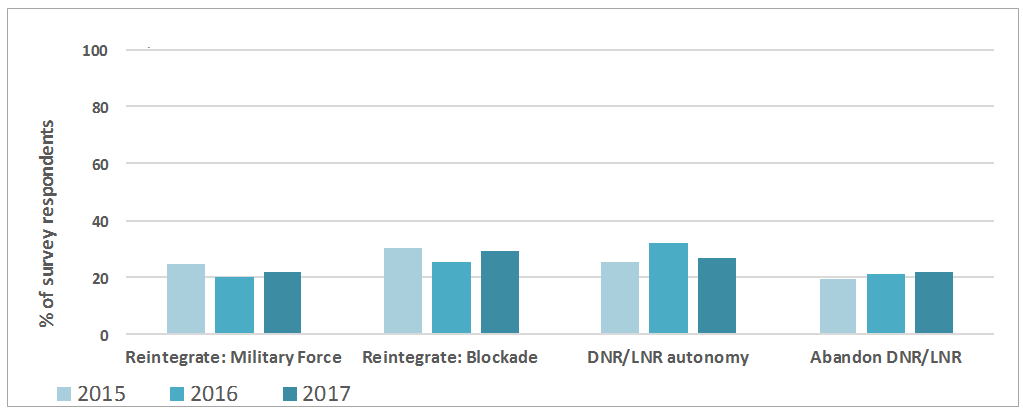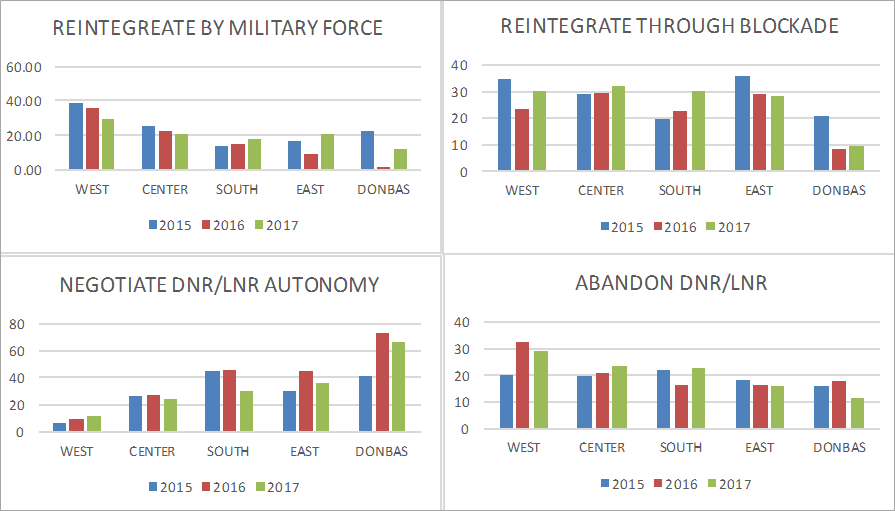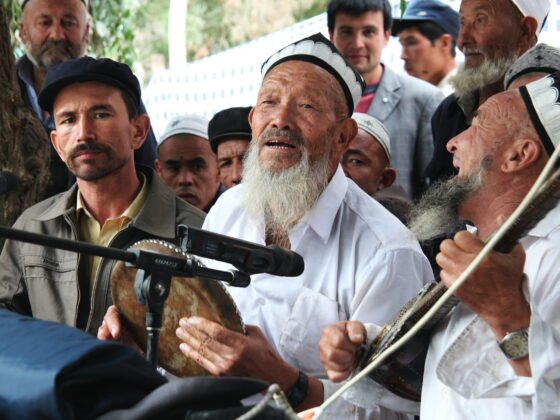(PONARS Policy Memo) Whereas it is hard to imagine the Donbas retuning fully to Ukraine’s control without Russia ending its multi-year military and economic backing of the separatist entities there, the question of the region’s reintegration is highly prevalent in Ukraine’s political and social life. The Donbas war has been the number one concern over the last three years among Ukrainians who now also see their government’s ability to end this war as a primary issue in the run-up to the 2019 presidential elections.
Opinion surveys, focus groups, and interviews across Ukraine indicate that public support across regional divides is more likely for candidates and prospective leaders who can properly articulate, and have the integrity to pursue, a balanced, multi-pronged Donbas settlement strategy that combines military buildup, selective sanctioning of separatist entities, and political negotiations. Such candidates or leaders would be more likely to attract undecided voters than those who prioritize only one resolution path. Those who articulate credible, national, socioeconomic development policies that are clearly non-contingent on, yet not prohibitive of, Donbas reintegration, have good chances of gaining public support, which in turn would advance sensible progress ending the often-deadly discord.
It’s a Big Issue
The Donbas war has a death toll of over 10,500, mostly due to Russia’s lethal military assistance to its client entities the Donetsk People’s Republic (DNR) and Luhansk People’s Republic (LNR). The conflict has been the top public concern in Ukraine for the past three years and is a central issue for the voters in upcoming elections.
• In nationwide opinion surveys by the Kyiv International Institute of Sociology (KIIS), the overwhelming majority of respondents picked “war in the East” as their number one concern: 72 percent in May 2016, 71 percent in May 2017, and 67 percent in May 2018.[1] Economic issues came second and third, but they were significantly less pronounced. In each year, 12-13 percent more respondents worried about the war than about their standard of living, and 21-23 percent more respondents worried about the war than about the economic situation in Ukraine in general.[2]
• In an April 2018 survey of 6,000 adult Ukrainians by the Rating agency, 67 percent of respondents picked “ending hostilities in Ukraine’s East” as a policy area in which they expected “top-priority changes from the next president of Ukraine.” This was 10 percent more than the number of those who said “the fight against corruption” and almost 20 percent more than those who said “the revival of industry.” These two issue areas came in second and third, respectively, to hopes of solving the conflict.[3]
Fight, Blockade, Autonomy, or Abandon?
The Ukraine Academy of Sciences’ Institute of Sociology surveyed Ukrainians on what conflict resolution scenario in the Donbas they found the most acceptable. Should Ukraine’s government use military force to reclaim the breakaway territories, impose an economic blockade, negotiate some form of self-rule, or abandon any effort to reintegrate them and let them go their own way? (Respondents could write in other solutions, but very few did.) Looking at the data from 2015, 2016, and 2017, three takeaways are particularly important.[4]
1. Over the years, it has become harder for an average Ukrainian to see how the conflict could be realistically resolved. The number of respondents opting out of the question rose from 23 percent in 2015 to about 28-29 percent in 2016 and 2017—making this group the largest in the survey sample. However, this trend may not necessarily signify the war has gotten more intractable or Ukrainians have become less optimistic in general because it is consistent with the next conclusion and the analysis of electoral preferences that follows.
2. The Ukrainian respondents are saying, collectively, that it is a good idea to pursue, to the extent possible, all of the four policy options. This suggests that a combination of these options rather than any single one of them would be closer to a collective societal preference.
• Across Ukraine as a whole, each hypothetical Donbas strategy—military victory, autonomy talks, blockade, or abandonment—has been consistently supported by about 20-30 percent of respondents year over year (see Figure 1).
• Ukrainian society is reluctant to rely first and foremost on war-fighting to attain victory, with only about 20 percent of respondents wanting this option. However, there is an approximate balance between the coercive (war-fighting and blockade) and non-coercive (talks and abandonment) options (see Figure 1).
• The preference for balanced multi-pronged strategies came through in seven focus group discussions that I commissioned in Donbas (Mariupol and Druzhkivka), Kyiv, Odesa, and Lviv in May 2017 and in my interviews with twenty-one Ukrainian residents in Kyiv, Odesa, and Kharkiv in June 2017.
Time after time, when asked about their ideas on how to end the Donbas war, the participants and interviewees often talked about several options while emphasizing the drawbacks of each. My interview with Vitaly, a 32-year-old engineer in Kharkiv in June 2017 illustrates the common, if not slightly scrambled, logic at the individual level. It is not that people may strongly advocate one or another approach or viewpoint, but they realize the limitations of each approach given, primarily, the cloud of external factors, namely the Russia-West dispute, even regardless of how they view Russia’s role. They often find it hard to reject any option, as Vitaly said:
“This is a conflict between the USA and Russia… Ukraine cannot resolve it… On the one hand, we must retake those territories, but the rebuilding of the infrastructure there would cost billions and we don’t have such resources. On the other hand, it would be easy to give them away. But then, what about people who have homes and families there? They would surely disagree with this. But for the sake of resolving the conflict, I would give away those lands. But then again, local residents would not agree. If, God forbid, the war flares up again, I would be getting involved to do something about it myself.”
Conversations like this suggest respondents had preferences but found it difficult to settle on a balanced, comprehensive solution, which would also be consistent with the high percentage of undecided respondents in the surveys. Yet my sense from the interviews was that ordinary Ukrainians are keen on seeing such solutions emerge.
3. A significant shift across Ukraine’s regions has occurred, bringing collective preferences for Donbas war resolution closer together across Ukraine. Whereas the Donbas remained an outlier in terms of its disproportionately high support for DNR/LNR autonomy talks and disproportionately low support for an economic and territorial blockade, preferences significantly converged across all other regions from 2015 to 2017 on most conflict resolution options, notably on the use of military force (see Figure 2).
• In regions where in 2015 support for fighting until victory was the strongest (West and Center), it declined. In regions where in 2015 it was the weakest (South and East), it increased. In the Donbas, the number of survey respondents opting for military victory dropped from about 22 percent in 2015 to just 1.2 percent in 2016, but then rose to nearly 12 percent in 2017 (being almost within the margin of combined sampling error with the level of support for use of military force).
• When it comes to imposing a blockade, differences in public support across all regions other than the Donbas gradually diminished (varying within a 15-percent range in 2015 but only within a 3-percent range in 2017).
• Regarding talks about DNR/LNR autonomy, outside the Donbas, the differences in public support narrowed across all other regions—from the highest of about 37 percent in 2015 to 24 percent in 2017—mostly driven by a marked decrease in the South and a rise in the West.
All three trends are compatible with one another and together suggest a growing preference for a balanced, multi-pronged strategy toward the Donbas issue.
Looking Toward the 2019 Election
A 2017 Ukrainian Academy of Sciences Sociology Institute national survey shows that Donbas policy preferences are significant correlates of prospective electoral choices.[5]
First, Donbas policy preferences are a strong political currency—they consistently relate to presidential approval ratings and voting choices independently of region, income, gender, education, urban/rural residence, and language. Notably:
• Residents of Ukraine’s West are more likely to approve of and vote for Petro Poroshenko and also to support the use of military force. However, across Ukraine, use of military force is a much stronger predictor of such support than residence in the West or any other region.
• Residents of the Donbas under Ukrainian control may appear to systematically disapprove of Poroshenko, but this relationship becomes no more than chance once support for autonomy negotiations with DNR/LNR is entered into the equation. This suggests electoral support in the Donbas region is crucially dependent on conflict resolution preferences more so than in other regions, but that incorporating elements of negotiation in the conflict resolution strategy would benefit candidates outside the Donbas as well. This would particularly work in the East and the South, as my interviews showed.
• Women appear to approve of Poroshenko’s job as president more than do men, but not after preference for military use of force is added to the model. The latter as well as support for the blockade also come through as stronger correlates of Poroshenko’s approval ratings than do income and Ukrainian language use.
Second, support for each of the four conflict resolution strategies in the surveys also translates into systematic voting preference for each of the seven major parliamentary parties and blocs whose leaders would be likely to run in the 2019 presidential elections. The overall trends—considering the narrowing of regional differences over Donbas conflict resolution—appear to subtly favor the incumbent president, Poroshenko.
• Likely voters (those intending to vote) who believed in retaking the Donbas through military victory are systematically more likely than others to support the Poroshenko Bloc, as well as the Samopomich and UKROP parties, both of which espouse strong support for Ukraine’s independent statehood and national identity. These respondents are also systematically less likely to support the Opposition Bloc and the Za Zhyttia (To Life) party that are both considered as advancing pro-Russia agendas. This pattern of support is reversed among the likely voters who backed autonomy negotiations with the DNR/LNR.
• The Poroshenko Bloc is the only party favored by respondents who support reintegrating the Donbas through a blockade aimed at weakening the Moscow-backed DNR/LNR separatists. Blockade supporters also are less likely than average to say they would vote for the Opposition Bloc and Za Zhyttia in a hypothetical parliamentary election. Moreover, support for the blockade but not for other Donbas options correlated significantly with the intent to vote. This potentially gives Poroshenko an edge among a sizeable segment of Ukrainian society.
• Of the major parties, the Poroshenko Bloc is the least regionally polarizing. Residence in none of Ukraine’s five major regions has a statistically significant correlation with the intended vote for the bloc (although it does significantly relate to presidential approval ratings). In contrast, both support for and opposition to other parties is more likely to be regionally concentrated. For instance, Yulia Tymoshenko’s Bat’kivshchyna party scores significantly higher than average among respondents in Central Ukraine and significantly lower among respondents in the Donbas. More likely than others, Svoboda and Samopomich would be supported in the West, but opposed in the East. The reverse would go for Za Zhyttia. And UKROP would be supported in the East, but opposed in the Donbas.
• Indirectly, Poroshenko has an edge among the largest group of likely voters—those who are undecided about which party to vote for. Those respondents (27 percent of the survey sample) systematically oppose the military use of force, autonomy, and abandoning the separatist entities in Donbas, but are neutral with respect to the blockade. If this pattern holds, Poroshenko would get more of a chance to come through as the least unfavorable candidate.
Conclusion
Donbas conflict resolution is a considerable political issue. Ukrainian public opinion trends appear to show that a door is open to new productive approaches and deep public discussions on the issue, which impacts the 2019 election cycle. Ukraine’s political players, old and new, would be well served if they support, and can detail, how a combination of policy options toward the Donbas would be effective. As Taras, age 44, a 2017 focus group participant from Lviv, said in a way that seems to best capture the general public’s outlook: there is the need to find viable, comprehensive, and predominantly non-violent ways to reintegrate the separatist Donbas territories into Ukraine. As part of this, he emphasized the need to strengthen good governance, the economy, the army, and capacity for civic mobilization, by which “then Russia, an aggressor, would not risk expanding into our territories. Afterwards… the diplomatic means of conflict resolution would start working.” Other group participants agreed.
Figure 1. Which Donbas Conflict Resolution Scenario is Most Acceptable?

Figure 2. What Are the Best Conflict Resolution Options?

Mikhail Alexseev is the Bruce E. Porteous Professor of Political Science at San Diego State University.
[PDF]
[1] N=2,014 (2016); N=2,040 (2017); N=2,025 (2018).
[2] KIIS polls’ margin of error (with a probability of 0.95 and with a design effect of 1.5) does not exceed 3.3 percent for figures close to 50 percent, 2.8 percent for figures close to 25 percent, 2 percent for figures close to 10 percent, and 1.4 percent for figures close to 5 percent.
[3] The reported margin of sampling error was less than 1.5 percent.
[4] Based on the author’s proprietary dataset from the Ukrainian Academy of Sciences Institute of Sociology.
[5] Based on the author’s proprietary dataset from the Ukrainian Academy of Sciences Institute of Sociology.










